

Unveiled 23/9/1897
Sculptor: Archibald McFarlane Shannan A.R.S.A (1902) d. 29/9/1915
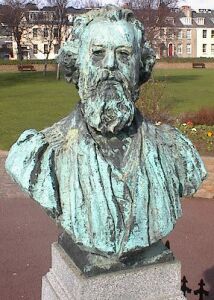
...Near this statue there has recently been erected a BUST of PHILIP BAUDAINS, Esq., who was for 15 years in succession Counetable of St. Helier. Mr. Baudains retired in 1896 through ill-health, but is now (time of writing) much better. There seems to be an advantage in erecting statues during the life-time of the original, and that is, that the former need not necessarily be like the latter. This, I think, is the impression of the Jersey people; I cannot say it is a commendable advantage or creditable to anyone connected with it, and the numerous admirers of Mr. Baudains will surely take early steps to do their hero greater justice.
London to the Channel Islands (ed. Matthias King 1899 p.13)
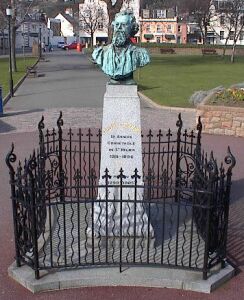
Le Buste Baudains
Oeuvre artistique
On se rappellera qu'il y a quelque temps les souscripteurs au Testimonial Baudains, décidèrent de lui ériger un monument qui serait son buste en bronze, en reconnaissance des éminents services rendus à la paroisse de St.-Hélier, pendant sa longue gestion de Chef Municipal. Notre habitude n'est pas d'user de flatterie envers qui que ce soit, mais de rester dans le vrai, et on ne nous accusera pas de sortir hors de cette voie quand nous dirons que Mons. Baudains comme administrateur des affires de la paroisse n'a pas eu son supérieur s'il a eu son égal.
Il n'est donc pas suprenant qu'il se soit trouvé des hommes qui aient voulu rendre hommage au citoyen distingué dont les efforts pour améliorer et embellir notre capitale ont dû coûter bien des peines et bien des soucis avant d'arriver à leur achèvement.
Et si à une époque déjà loin de nous on a élevé un monument au Connétable Le Sueur pour services rendus à sa patrie à plus forte raison devait-on en élever un à notre ex-Connétable Baudains qui a prêté toute son énergie et un temps considérable au développement et au bien-être de la paroisse qu'il a régi pendant 15 années consécutives. Les initiateurs de ce monument ont pensé avec raison que le moins qu'on pût faire était de perpétuer sa mémoire par ce moyen et de le donner en exemple à ceux qui le suivront.
Le buste est en bonne voie et en bonnes mains étant soumis au ciseau de M. A. Mac Farlane Shannan, de Glasgow, et un petit nombre des amis de M. Baudains, sur l'invitation de M. Bois (Sec.-Hon. du Comité pour le Testimonial), se sont rendus au domicile de M. Baudains où ils ont pu examiner et admirer cette oeuvre artistique dont le modèle est en argile français. La ressemblance est frappante et la pose comme orateur ne peut être mieux rendue que celle qui lui a donné l'éminent sculpteur. En un mot, ce monument, tout en étant une représentation fidèle de celui qui en est l'objet, sera également une preuve qu'il se trouve des hommes dont la reconnaissance n'est pas une chimère mais une réalité.
Nouvelle Chronique de Jersey 10/3/1897
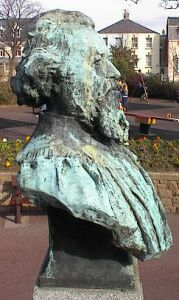
The bronze bust, which reflected the greatest credit upon the artistic skill of Mr. A. McFarlane Shannan, rested upon a granite pedestal some 6ft high, with a granite base. The height of the whole is just over 10ft. The pedestal is in one solid block, weighing about a ton and three quarters, and special interest attaches to the fact that it was brought from a quarry belonging to Mr. Baudains, and situated at Rosnez, St. John's. On one panel is the inscription:-
Philip Baudains
Mayor of St. Helier
1881-1896
On another panel is the inscription:-
"Erected by public subscription in recognition of services rendered to his country"
The other two panels contain French translations of these two inscriptions. The pedestal is nicely shaped and ornamented, and does full credit to Mr. F.T. Carter, statuary mason, Windsor-road.
The pedestal and bust are surrounded by tastefully ornamented iron railings, the contractor being Mr. H. Webber, Aquila-road. At each corner of the railings appears the monogram "P.B.," worked in the design.
In order to complete the appearance the services were requisitioned of Mr. J. Thatcher, decorator, of the Parade, and he has painted the railings in French grey, tastefully picked out in gold.
The whole design and execution is strikingly effective, and will prove an adornment to the artistic attractions of the town.
Jersey Express 24/9/1897

"At each corner of the railings appears the monogram "P.B.," worked in the design"
The Bust itself is a faithful facsimile of the clay model in its finished state, and as a rare specimen of art, does credit alike to Mr. McFarlane Shannan, the able artist, and to the founders of it. It appears full of animation; and what we said in a former issue (March 16, 1897) (note: actually 6/3/1897) concerning what might be expected from the model, now comes out perfectly true with regard to this, the final result:
It is artistic, human and suggestive in the highest degree, and hence is calculated not merely (as is sometimes the case with such things) to represent so much dead weight of metal, variously outlined or in relief, but the exact portraiture of the head and shoulders of a living man; a credit to the subject, the sculptor and the Island. Neither does it, in our opinion, represent merely a bust to be passed by with the remark, "Oh yes, I forgot, that's the bust of ex-Connétable Baudains, you know," and nothing more but a work of art to ponder over and to study. One which, when future generations ask what was the man like whose name is yet known on account of the noble service he rendered, and wherein lay his power, those generations will have wherewith to satisfy their longings to know and their desire to behold a living semblance of him in his prime, one that artists can pencil if they desire, phrenologists "weigh up" if it be their will, and physiognomists judge according to their powers. The bust represents ex-Constable Baudains a few years younger than at present - a sine qua non, this, when the great object is the perpetuation to future generations of the man as he was when his main work was achieved - and its suggestiveness and therefore humanity, so to speak lies in the fact that from whichever point it is viewed, the beholder has unfolded to him a different aspect of the characteristics of the living person. The profile itself is a speaking likeness of Advocate Baudains as he might be imagined in the midst of a weighty discussion, determined to carry his point, when - the brain just about to solve some knotty theory, the lips alive to burst with that eloquence he so well displays - he is about to raise his finger not so much to appeal for, as to command, attention. Catch a glimpse of it as with one eye full in view, the other eyebrow appears over the bridge of the nose, you have the attitude of deep thought; a full three-quarter face will give you a vivid view of it when a thing or person is being eagerly sought for; a full face, when that desire has been achieved; whilst hovering around the whole (though the face is decidedly that of one in an official capacity, and the garb thrown artistically over the shoulders that of a Mayor's gown) there hangs, to be mentally caught, if looked for, a reminiscence of the geniality and sense of humour so well known. Indeed, view the bust from where you will, new suggestions arise; new imaginative pictures ever and anon crop up. And it is in this manner that the bust lives and speaks. It is no use multiplying instances, the public will have its own opportunity for testing it. One more item, however, must be added, that is the most clever way in which Mr. Shannan has endowed the back of the head with character - in which respect it must never be forgotten, though it is scarcely ever thought of, that a man displays almost as much character in his back as he does from other views - and as ex-Constable Baudains would not be himself without the characteristically-bushy manner he wears his hair at the back of his head, so neither would the bust be one of ex-Connétable Baudains if it did not present the exact facsimile of it. In this, as in all the other peculiarities and details, Mr. Shannan has proved himself a real master. With regard to the general features and the likeness as a whole, we have nothing to add, except that they could not thus speak as they do unless they were real; and in conclusion we can only say that those who appreciate ex-Constable Baudains' work most will be foremost in their gratitude to the sculptor, Mr. A. McFarlane Shannan, for giving them , and leaving to posterity, so worthy a bust of one of Jersey's most worthy sons.
The Pedestal is from the elegant designs of Mr. Adolphus Curry. In form it presents a square column gracefully tapering from 2ft. 8in. over all at the base to 1ft. 4in. at the top, the height being 5ft 6in, whilst the four corners at its base are beautifully decorated in relief by scroll work of the leaf pattern, nearly meeting at the central points of each side of the column and gracefully dying out as they ascend it. The pedestal is surmounted with a cap some six inches in depth, upon which comes the bust, and the whole rests on a platform-like basis which may best be described as a square with its sides hollowed out in segments of a circle, and shewing about three inches above the ground, thus throwing the bust itself just upon 9ft. 6in. or so above the soil, and giving, as was intended, practically a real life-size impression when viewed by the ordinary onlooker.
As a finishing touch, too, to this notable ornament to the Parade, the pedestal is surrounded by a kerb some 7 inches wide, showing about the same from the ground, and following the outline of the platform base. Most elaborate and beautifully designed railings, the work of Mr. Webber, of Aquila-road, run around this kerb, and, whilst adding to the general effect, afford a protection to the pedestal, with its noble bust.
Then another very interesting item comes to the fore in the fact that the whole of the work on the pedestal and curb was wrought at the yard of Centenier Carter, who not only has taken the utmost care to do everything in the best style possible, but has also succeeded in a most congratulatory manner. Though additional interest even must attach to the fact that the diorite (a species of dark grey granite) used came primarily from the quarry at Ronez, St. John's, owned by ex-Constable Baudains. The block, that is to say from which the pedestal itself is formed, in weight some 3½ tons, was found in the form of an immense boulder lying on the sea-shore about 200 feet from the quarry itself. And experiments having proved the worthiness of the material, the boulder was "fished" up by means of a barge and subsequently conveyed to Mr. Carter's yard, where it took nearly three months to work into its present finished state. In appearance, this, the first specimen of this sample of diorite used in Jersey, proves itself to be far superior to any granite hitherto found in the Channel Isles, and whilst it has all the marked characteristics of the best of the celebrated Dumfries granite (or diorite), it surpasses it in the beauty of its close wavey-like "grain."
Evening Post 23/9/1897
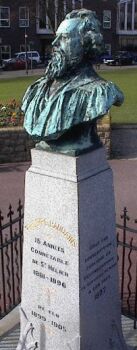
The long-anticipated ceremony of unveiling the monument to Advocate Ph. Baudains (ex-Constable of St. Helier) took place in the Parade at 2.30 o'clock yesterday afternoon, with distinct éclat.
This bronze bust was, it may be useful to recall, subscribed for by some 1,000 persons collections among whom producing a total of about £330; and we have already described it at length as a real work of art. The commission therefore was entrusted to clever Mr. A. McFarlane Shannan, of Glasgow, who has already won a proud name as a sculptor, and general admiration has been expressed at the result of his labours. The bust was recently erected on a pedestal cut from a block of granite provided by Mr. Baudains from his own quarries in his native parish of St. John. This was designed by gifted Mr. Adolph. Curry, C.E., and the work carried out by Mr. F.T. Carter (monumental mason), the base being tastefully relieved with scroll-work, and the whole mounted on a kerb and railed-in - the chosen site being the centre of what we may call the upper Parade, at the juncture of several pathways......
Mr. Adolph Curry said he had been entrusted with the honour of proposing the toast which he thought they would all agree with him was not the least important. The gentleman whose health he asked them to honour heartily was that of Mr. Shannan, the sculptor - the very clever sculptor, he might say, as they had been able to testify for themselves that day; for the unveiling of the monument showed how very creditably the Committee had acted in discharging the mandate reposed on them. He regretted Mr. Shannan was not able to be with them; but he learnt he had some very important engagements - and a man of his abilities would have such - as to work of a similar nature. His work would, he thought all would agree, be looked-upon with pleasure for years and years to come; for it was a work of art, and the difficulties which he had to contend with were not slight. The gentleman he had to portray four or five months ago did not look like the gentleman they saw that day; and he was sorry Mr. Shannan was not able to see how different Mr. Baudains now was to when he was here last. Mr. Curry then called on the company to drink Mr. Shannan's very good health; and also to give him, as he was unable to reply, three hearty cheers...
Jersey Times and British Press 24/9/1897
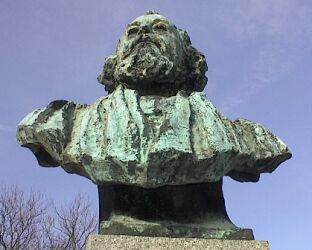
Qui sait, si Mons. Baudains est encore quelques années à la tête de la Paroisse, peut-être qu'on s'avisera de donner des bras et des jambes à son buste dans la Parade. Il faut l'espérer, du reste, car ce buste ne lui fait guère honneur et pour en dire le moins il est bien vilain...
Nouvelle Chronique de Jersey 14/6/1899
La Statue du Connétable Baudains
Quelque personne malveillante a, pendant la nuit de Mercredi à Jeudi, jeté du goudron sur le piédestal du buste érigé en honneur de notre estimé Maire, dans la Parade.
Nouvelle Chronique de Jersey 26/5/1900
Malveillance -
Mardi soir quelque personne mal disposée a blanchi le buste de la statue de notre estimé Connétable, P. Baudains, dans la Parade.
Nouvelle Chronique de Jersey 9/6/1900
La Statue du Connétable Baudains
Quelques personnes malveillantes ont peint en rouge la figure du buste de notre estimé Connétable, qui est situé dans la Parade.
Nouvelle Chronique de Jersey 8/8/1900
A contemptible action
During the night the bust of Constable Baudains was again tampered with, the whiskers and nose being daubed over with red paint. This contemptible sort of work is almost beneath contempt; at the same time the perpetrators thereof deserve the severest punishment that can be meted out to them
Evening Post 4/8/1900
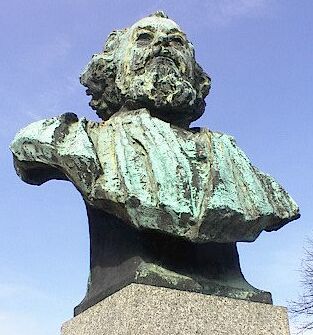
Les Iles de la Manche
Tel est le titre d'un volume que nous venons de recevoir et pour lequel nous remercions M. Henri Bolland, l'habile auteur.....
M. Bolland en parlant de la Parade dit qu'elle est ornée du bustee du Connétable Baudains "entré vivant dans l'immortalité." Souhaitons à notre estimé et populaire Connétable une "immortalité" beaucoup plus durable que celle de son buste sur la Parade!...
Nouvelle Chronique de Jersey 27/7/1904
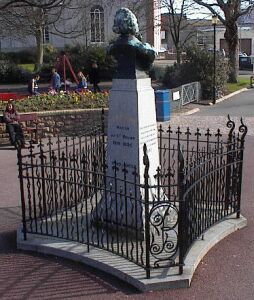
In the Parade, in the centre of the Gardens and Lawns, and further to the North West than the Don Monument, is the Bust of a Gentleman, with his face towards the Town Hall. His name was Phillippe Baudains.
He was an Advocate of the Royal Court and Constable of St. Helier from 1881 to 1896, and from 1899 to 1905.
The Bust was erected in 1897.
There is an amusing story concerning this statue. Some years ago, when Breton Labourers were brought to the Island annually for the Potato Harvest, some of them might have been seen kneeling before this Bust in earnest prayer. They had thought it to be a statue of St. Helier, the Saint after whom the Town is named.
A Tour of St. Helier Jersey Chamber of Commerce 1937
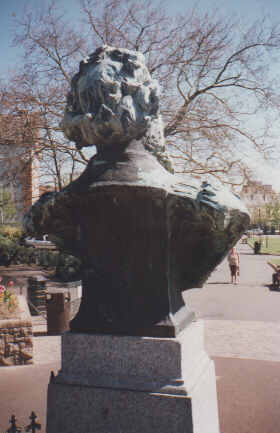
Owed
to
Philip Baudains, Esq.,
On his fourth nomination as
Constable of St. Helier's, Jersey.
(Impromptu)
He's a proper sort of brick
And to him, the Town will stick,
As Constable, we need no other party;
He's a jolly nobleman,
Who does all the good he can;
So we give him thanks and cheers, true and hearty.
May 30th, 1890
Nouvelle Chronique de Jersey 31/5/1890
